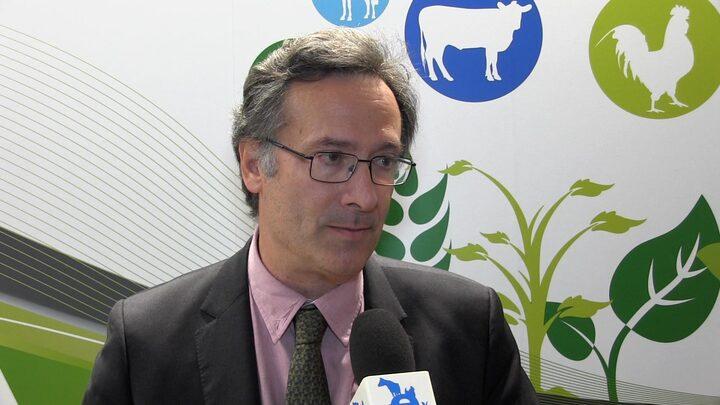Explore all the information on
Poultry nutrition - Other additives
Alternative feed additives have promising importance in broiler production due to the ban on the use of certain antibiotics. The most used antibiotic alternatives in broiler production are phytogenics, organic acids, prebiotics, probiotics, enzymes, and their derivatives. Antibiotic alternatives have been reported to increase feed intake, stimulate digestion, improve feed efficiency, increase growth performance, and reduce the incidence of diseases by modulating the intestinal microbiota and immune system, inhibiting pathogens, and improving intestinal integrity. Simply, the gut microbiota is the target to raise the health benefits and growth-promoting effects of feed additives on broilers. Therefore, naturally available feed additives are promising antibiotic alternatives for broilers.
Dr. Randy Payawal (Nuscience) shares his research on a medium chain fatty acid and its ability to control pathogens, during the 5th IHSIG Symposium on Poultry Intestinal Health in Bangkok, Thailand....
Comments : 4
Recommendations: 3
Ken Koelkebeck (University of Illinois), program coordinator, talked about the collaborative work to put together this traditional event and the plans for next year's meeting....
Comments : 0
Recommendations: 4
João Batista Lancini, DVM, MSc, Poultry Health Consultant, Lavenco Consultant, comments on the experience using Silvafeed® Nutri P, a natural extract used in the Brazilian feed additive poultry market, during the 2019 Multi-State Poultry Feeding and Nutrition Conference and Silvateam’s Technical Symposium.
...
Comments : 0
Recommendations: 2
The Problem Endotoxins are potentially toxic compounds from bacterial origin. The most well-known endotoxins are lipopolysaccharides (LPS), which are part of the cell wall of Gram-negative bacteria. In poultry, the GI tract is a large reservoir of microorganisms, and therefore the most important source of endotoxins. During normal bacterial division and lysis, LPS molecules are released into the lumen. Once absorbed from the lumen, endotoxins induce an inflammatory response,...
Comments : 0
Recommendations: 4


Enhancing Egg Production: Key Factors Influencing Chicken Health and Yield
Suggested link
Endotoxins (lipopolysaccharides or LPS) are part of the cell wall of Gramnegative bacteria. During growth or bacterial lysis, LPS are released and can transfer to blood and tissues. In poultry, the intestinal microflora is the most important source of endotoxins, and the GI tract the main risk site for transfer from the lumen. Several factors (e.g. heat stress, mycotoxins, pathogens, feed transition) are known to increase gut permeability, promoting leakage of endotoxins into the blood. Once...
Comments : 2
Recommendations: 7
Abstract
It is recognized that the benefits of eubiotic feed additives are not consistently demonstrated in research trials, especially in a clean environment without any challenge. Understanding factors affecting their efficacy will facilitate mechanism of action investigation and guide practical application. A battery trial was conducted with 384 day-old male broilers to evaluate the effect of protected benzoic acid on growth performance and gut health of broilers...
Comments : 1
Recommendations: 1
Abstract
An experimental direct-fed microbial (DFM) was evaluated in a dose- response trial to determine broiler live performance to 42 d with Coccivac® B at placement (d 0), used litter on d 4, and toxin-producing Clostridium perfringens (Cp) challenges on d 17-18 (by oral gavage and via water trough daily). There were 8 dietary treatment groups with 10 replicate pens of 30 chicks each per treatment (2,400 Cobb 500 straight- run chicks total)....
Comments : 1
Recommendations: 0
Dr. Bob Swick, University of New England, Armidale, NSW Australia, discusses the main aspects to be considered in early chick nutrition, during VIV Asia 2019...
Comments : 0
Recommendations: 0
I boiled cattle blood and dried it as feed for chicken. It became too hard to crush.
How do i make blood meal soft for grinding after boiling and drying...
Comments : 1
Recommendations: 0
1. Introduction Historically, biological active substances in herbal plants are considered the main sources for preventing and treating infectious diseases. They are also applied as protective drugs in human. Many investigators have explained that some herbal plants have biological active materials are able to increase animal production and act as antibacterial drugs [1,2]. The attention on herbal plants as growth promoter has gained more focus especially after banning...
Comments : 2
Recommendations: 1
.jpg&w=3840&q=75)

All-in-one mycotoxin extraction method for faster time-to-results - Myco 5-in-1 PLUS
Suggested link
Introduction
The basis of the modern poultry meat industry dates back to the late 1950s and nowadays, poultry meat is one of the most important protein sources in human diet. Global poultry meat production in 2000 was 69 million tons and this has been increased to over 97 million tons in 2010 (Windhorst, 2011): an annual production of approximately 70 billion broilers originating from approximately 600 million broiler breeders. These data underline how a relatively...
Comments : 0
Recommendations: 1
INTRODUCTION Feed cost accounts for more than 65% of variable cost of producing poultry products, and energy and amino acids account for more than 90% of this cost (Kiarie et al., 2013). In the recent past, the global feed industry has seen soaring and volatile prices of traditional feedstuffs commonly used in livestock and poultry diets due to competition with the food and ethanol industries (Woyengo et al., 2014). Moreover, in the context of anticipated human population...
Comments : 0
Recommendations: 0
Introduction The Layers are the most productive egg producers in the entire world. The innovative techniques had not been examined to improve energetic potential of hens. In Recent scenario, a hen may be produced annually 280 to 320 eggs (Soomro et al ., 2015). Mostly Leghorn Hens preferred for commercial egg production due to low height, weight and produce the maximum egg production. Different growing techniques are practiced and organized as modern...
Comments : 0
Recommendations: 0
Mark Blakley (EW Nutrition) discusses the prevention and treatment of this disease through drinking water as well as feed, during IPPE 2019 in Atlanta, USA....
Comments : 0
Recommendations: 0
What is the max I can feed of meat and bone meal to broilers and turkey? ...
Comments : 2
Recommendations: 0
INTRODUCTION During the last 50 years, as a growth promoter in farm animal, the use of antibiotics has been questioned. It is clear that antibiotics benefit for growth, performance and health in animal and poultry. Most of antibacterial performance promoters have been prohibited, because feeding of antibiotics is risky which the last ones removed in January 2006 (Neu, 1992). The adjustments following the withdrawal of these products in animal production have been difficult at times and...
Comments : 7
Recommendations: 3
Everton Krabbe (Embrapa) talked about protocols and issues involved when developing products, during the 1st PoultryUniverse Coccidiosis Congress in Curitiba, Brazil....
Comments : 1
Recommendations: 1
Introduction The ban on use of antibiotics as growth promoters in EU since 2006 endorsed the finding of alternative to antibiotics in farm animal nutrition (Attia et al., 2006; 2012; El-Deek et al., 2011). Thus, search for effective alternatives to antibiotics in intensive animal production is a very important topic, considering not only the impact in animal welfare but also in human health. Antibiotic-resistant bacteria (whose number is increasing year by year) are considered...
Comments : 0
Recommendations: 2
Conclusions The dietary inclusion of Bacillus amyloliquefacien s CECT 5940 (Ecobiol®), antibiotic growth promoter (AGP), or competitor probiotics ( Bacillus subtilis A, and B) significantly improved feed conversion, reduced footpad lesion and C. perfringens in ileum while providing better carcass yield compared to the challenge group without additives. Furthermore, uniformity of the body weight was significantly better in...
Comments : 0
Recommendations: 1
Introduction The first days of life are very critical for gastrointestinal (GI) maturation and immunity development, especially for high yield breeds. However, in commercial hatchery practice the birds within this period exposures for many stressors, such as newly hatched chicks remain for up to 36 hours after hatching before they are pulled from hatching cabinet and then it followed by hatchery processes (sexing, counting, packaging). After these processing newly hatched...
Comments : 0
Recommendations: 1



.jpg&w=3840&q=75)






.jpg&w=3840&q=75)

























